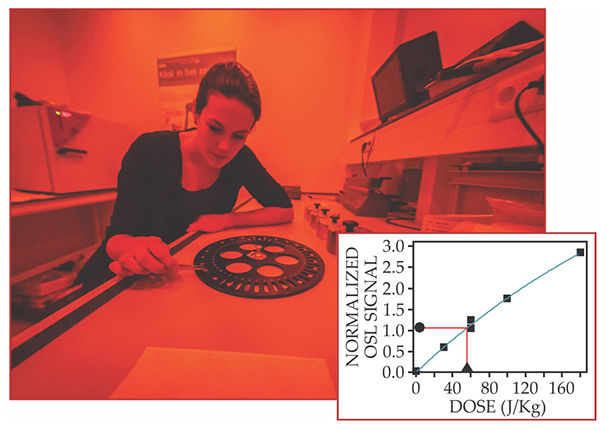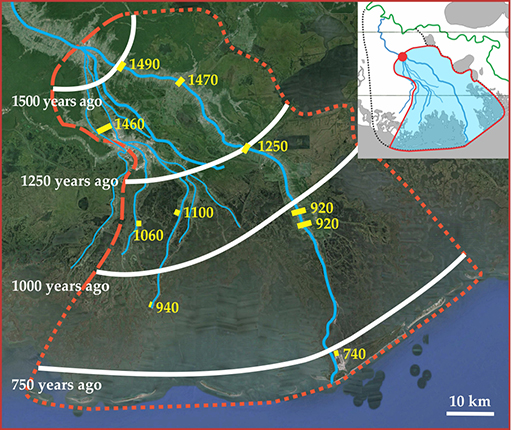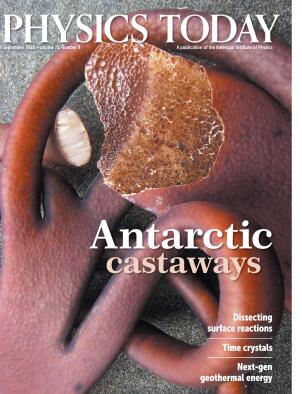A bright approach to geochronology
DOI: 10.1063/PT.3.4030
Imagine a grain of quartz sand lying on the bank of the upper Mississippi River, at the boundary between Minnesota and Wisconsin. The grain is picked up by rising springtime water and travels hundreds of kilometers downstream, through a series of locks and dams, past the relict boomtown of Cairo, Illinois, where the Mississippi swells with input from the Ohio River. The river grows several more times through the lower Mississippi River valley as tributaries contribute water and sediment to its sinuous flow. Along the way, the grain may be stored underground, perhaps for a long time, or exposed to daylight as it rests temporarily on river bars or banks.
Ultimately, the quartz grain reaches the Mississippi delta of southeastern Louisiana, where the river meets the ocean and deposits its sand and mud. The grain is surrounded by others as it settles to the bottom of a shallow bay and contributes to the formation of new deltaic land.
Coasts and deltas are among the most vulnerable landscapes on Earth. During the past century, for example, the Mississippi delta suffered an average net land loss of 45 km2/year. Acquiring knowledge of how those dynamic regions operate is essential for managing sediment resources provided by rivers and for predicting future land change.
A brief and tiny spark
Once a grain is deposited, it and others are slowly dosed with ionizing radiation that comes primarily from the decay of naturally occurring radionuclides in the surrounding sediment. The electrons liberated from their crystal-lattice sites by the radiation are stored in traps related to defects of the mineral. When the grain is next exposed to light or heat, those electrons can recombine with electron holes associated with the vacated lattice sites to release the stored energy as photons. The result is a tiny flux of light, a phenomenon known as luminescence. The luminescence clock begins to tick when a grain is removed from light, and it is reset when the grain is exposed to light for a sufficient time, as can happen when a bit of quartz rafting down the Mississippi temporarily rests on a sunlit riverbank.
Optical dating uses the luminescent property of quartz or feldspar grains to estimate the burial age of sediment or archaeological features. Because luminescence signals are sensitive to light, researchers must prepare and handle samples in a darkroom under dim amber or red light, as shown in figure
Figure 1.

Optically stimulated luminescence (OSL) measurements must be made in controlled darkroom conditions. Here, Wageningen University’s Erna Voskuilen prepares sand samples for analysis. The curve in the plot interpolates the OSL signal (squares) of quartz grains exposed to known radiation doses. Such a plot allows one to deduce the natural dose absorbed by buried grains (triangle) from a measurement of their OSL signal (circle). (Photograph courtesy of Guy Ackermans.)

When quartz won’t do
Thermoluminescence dating, which uses heat rather than light to stimulate the sample, was introduced in the 1960s. Its main application today is to such archaeological tasks as dating fired pottery or hearth deposits. Optical dating first appeared in scientific literature in a 1985 paper, written by David Huntley and colleagues, that was tailored toward applications in geology. Since then it has rapidly evolved and is now applied to various sediments and scientific questions.
Quartz is generally the preferred mineral, because the OSL signal is quickly reset and because it has the most stable of the signals that can be targeted: Electrons trapped in quartz don’t readily escape unless the mineral is stimulated by light or heat. Optical dating with quartz can yield reliable ages ranging from tens of years up to 150 000 years. In some cases, though, the upper age limit can be as low as 30 000 years because of local dose rates and saturation behavior, meaning grains can store only a limited number of electrons in defects.
Quartz OSL sensitivity increases with repeated cycles of burial and resetting for reasons that are still not clear. In fact, quartz sediments mobilized from igneous or metamorphic rocks and transported over short distances or for short periods of time are often not very bright. Quartz OSL records are thus limited in basins near orogenic settings, locations where tectonic plates are pushed up to form mountains, such as alpine glacial valleys or the Ganges–Brahmaputra Delta at the base of the Himalayas.
Feldspar can be an alternative in such challenging settings. In IR-stimulated luminescence (IRSL), the feldspar signal is induced by optical stimulation at a wavelength of about 875 nm. The mineral provides two benefits over quartz. First, feldspar is often born sensitive. Second, the feldspar IRSL signal saturates at higher doses than does the quartz OSL signal, so the mineral can be used for dating that sometimes extends beyond 500 000 years. Feldspar’s drawbacks are that it is not as readily reset as quartz and it is not as stable. The instability can be circumvented with novel techniques that target more stable but less readily reset feldspar signals.
Dating deltas
Since optical dating was introduced, innovations in measurement protocols have increased the time and geographic ranges of the approach. Optical dating now is applied to archaeological efforts and to a wide span of geologic research, including geomorphology, glaciology, and coastal science. The technique became applicable to river sediment and delta assessment in the early 2000s, due to advances in measurement procedures and statistical methods that allow for its use when only a fraction of sand grains in a deposit have been reset prior to deposition.
Radiocarbon dating is one way to assess the chronology of subdeltas of the Mississippi delta. The technique makes use of the ratio of radioactive carbon-14 to stable carbon-12: Both isotopes are captured by all living organisms, and 14C decreases at a known rate once they die. The application of radiocarbon dating to landscapes requires the preservation of relevant plant or animal remains, a condition that is often not met.
In my research, my colleagues and I used quartz OSL to date the shoreline migration of a large portion of the Mississippi delta known as the Lafourche subdelta. The OSL ages we determined (see figure
Figure 2.

The Lafourche subdelta, just southwest of New Orleans, began to grow about 1600 years ago and remained active for about a millennium. Our study focused on the portion of the subdelta colored blue in the inset; the full subdelta is bounded by the dotted black line and the present-day Mississippi River in green. In the main figure, the large red dashes denote the preexisting shoreline of the study region and the small red dashes indicate the extent of land creation, some already eroded by the sea. The yellow lines indicate areas where we obtained optically stimulated luminescence ages (also yellow) for quartz samples. Those ages tell when the sediments were deposited. Typical uncertainties are 5–10%. The time history of land deposition is interpolated in white; roughly speaking, the land grew radially from the polyfurcation point marked in red in the inset. (Adapted from E. L. Chamberlain et al., Sci. Adv. 4, eaar4740, 2018.)

We found that the average preindustrial land-growth rate in the studied portion of the Mississippi delta was 6–8 km2/year, yielding a considerable amount of new land over the subdelta’s thousand-year lifespan. But the preindustrial growth rate was much less than the current land-loss rate of 45 km2/year observed in the postindustrial system, and the growth we measured occurred at a time when sea-level rise was slow (0.6 mm/year) and stable. Net land loss in the Mississippi delta is likely to continue, especially as the rate of sea-level rise accelerates through the 21st century.
References
► D. J. Huntley, D. I. Godfrey-Smith, M. L. W. Thewalt, “Optical dating of sediments,” Nature 313, 105 (1985). https://doi.org/10.1038/313105a0
► J. Wallinga, “Optically stimulated luminescence dating of fluvial deposits: A review,” Boreas 31, 303 (2002). https://doi.org/10.1111/j.1502-3885.2002.tb01076.x
► A. G. Wintle, A. S. Murray, “A review of quartz optically stimulated luminescence characteristics and their relevance in single-aliquot regeneration dating protocols,” Radiat. Meas. 41, 369 (2006). https://doi.org/10.1016/j.radmeas.2005.11.001
► E. L. Chamberlain et al., “Luminescence dating of delta sediments: Novel approaches explored for the Ganges-Brahmaputra-Meghna Delta,” Quat. Geochronol. 41, 97 (2017). https://doi.org/10.1016/j.quageo.2017.06.006
► E. L. Chamberlain et al., “Anatomy of Mississippi delta growth and its implications for coastal restoration,” Sci. Adv. 4, eaar4740 (2018). https://doi.org/10.1126/sciadv.aar4740
More about the Authors
Elizabeth Chamberlain is a postdoctoral research fellow with the department of Earth and environmental sciences at Vanderbilt University in Nashville, Tennessee, and the Netherlands Centre for Luminescence Dating and the soil geography and landscape group at Wageningen University.

